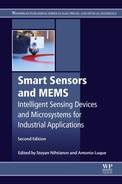Advanced silicon radiation detectors in the vacuum ultraviolet and the extreme ultraviolet spectral range
Abstract
In this chapter, the numerous challenges in reliable measurement of vacuum ultraviolet (VUV) and extreme ultraviolet (EUV) radiation with silicon radiation detectors will be discussed. The most severe issue is the high absorbance of any kind of material in these spectral ranges, which poses stringent requirements on possible detector designs. In particular, a high value of the spectral responsivity and the necessary radiation hardness put contradicting demands on the devices. To find a solution, it is necessary to describe and understand in detail the basic physical processes for the interaction between the radiation and the detector. The spectral responsivity of VUV and EUV detectors is measured using monochromatized synchrotron radiation as a radiation source and electrical substitution radiometers as primary detector standards. We will present selected types of silicon-based semiconductor detectors and discuss their performance in the context of the named aspects.
Keywords
7.1. Introductory overview
7.2. Challenges for radiation detection in the VUV and EUV spectral ranges


7.3. Device solutions for radiation detection in the VUV and EUV spectral ranges
7.4. Methods of radiometric investigation and characterization

7.5. Spectral responsivity and radiation hardness of VUV and EUV radiation detectors



- 1. Growth of surface contamination layers: The detectors are used in vacuum because the radiation itself can only propagate in vacuum. The photon energy, on the other hand, is sufficiently high to ionize the residual gas atmosphere. The most abundant species in a common vacuum system (water and hydrocarbons) are cracked and the resulting radicals either stick to the surface and create carbon contamination or initialize oxidation in case of O
 H. Nitridation of the SiO2–Si interface turned out to be advantageous for radiation hardness (Korde et al., 1993). For prolonged irradiation, however, these oxide-passivated diodes degrade extensively (Scholze et al., 2002, 2003).
H. Nitridation of the SiO2–Si interface turned out to be advantageous for radiation hardness (Korde et al., 1993). For prolonged irradiation, however, these oxide-passivated diodes degrade extensively (Scholze et al., 2002, 2003). - 2. Surface charging of insulating surface layers (such as SiO2) due to external photoelectron emission: This issue was already addressed in the early investigations of VUV diodes (Korde and Geist, 1987), and changing from p-on-n to n-on-p polarity was suggested as a solution, because in this case the surface charging enhances the intrinsic field of the junction. Particularly, the formation of inhomogeneities was observed when irradiating photodiodes with a small beam (Fig. 7.7(a)) (Scholze et al., 1996). During an initial time period, the responsivity in the irradiated spot is stable but the region around the spot degrades. This was explained by a negative charging of the adjacent diode region due to photoelectrons accelerated back to the surface by the positive charge inside the irradiation spot and landing nearby on the oxide. This was proven by recovering the initial responsivity with a short irradiation of the initially shadowed area (Scholze et al., 1996).
- For the VUV spectral range, a pure-boron p-on-n diode was irradiated with a small beam. As discussed, for this polarity the positive charging of some parasitic oxide (probably grown in pinholes of the boron layer) decreases the responsivity. Fig. 7.8 shows the recovery of the responsivity over time because of a surface discharge process. This recovery, within a period of days, also indicates that the effect must be caused by rather small islands of oxide in a conductive matrix because the recovery is even slower for homogeneous oxide layers.
- In real devices, as shown in Fig. 7.2, the reverse contact forms an outer ring around the sensitive region and the inner contact ring for the face of the electrode. It is connected by deep-implanted doping to the reverse of the diode. The insulation between these two electrodes is usually achieved with SiO2. Irradiation of this region also charges the oxide, which, in this case, mainly results in an increased dark current (Shi et al., 2011).
- 3. Intrinsic damage (e.g., by creation of trapping states): This type of damage can be understood as a persistence of the initial impact of the primary process of charging (i.e., the creation of dangling bonds or other types of activated centers in the passivation layer of the diodes). This may result in permanent recombination centers or facilitate oxidation in the presence of O
 H radicals (i.e., residual water vapor in an unbaked vacuum system). The damage of the nitrided interface for a high irradiation dose could, indeed, be correlated to a radiation-induced oxidation of the surface as the K-absorption edge of O becomes more prominent in the spectral responsivity curve (Scholze et al., 1996). It is supposed that the combination of radiation-induced dangling bonds at the oxide–silicon interface in combination with O
H radicals (i.e., residual water vapor in an unbaked vacuum system). The damage of the nitrided interface for a high irradiation dose could, indeed, be correlated to a radiation-induced oxidation of the surface as the K-absorption edge of O becomes more prominent in the spectral responsivity curve (Scholze et al., 1996). It is supposed that the combination of radiation-induced dangling bonds at the oxide–silicon interface in combination with O H radicals facilitates surface oxidation. Consequently, the oxide was substituted by an alternative passivation layer. Contamination was particularly investigated in the context of space-based VUV spectroscopy.
H radicals facilitates surface oxidation. Consequently, the oxide was substituted by an alternative passivation layer. Contamination was particularly investigated in the context of space-based VUV spectroscopy.


7.6. Future trends
- • The devices are usually silicon devices. Only for applications where high VUV sensitivity and simultaneously no responsivity in the UV and VIS are required (solar blindness), also wide-gap materials are in use.
- • All detectors with insulating top layers have severe issues with radiation hardness. At the moment, only highly boron-doped diodes achieve high VUV responsivity and radiation hardness simultaneously.
